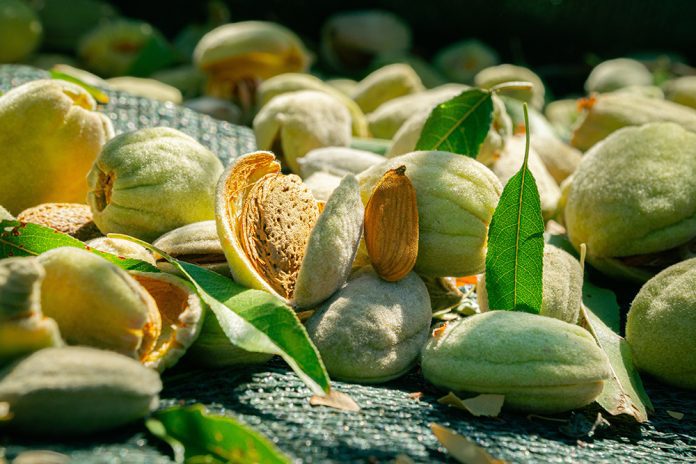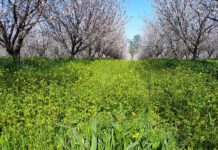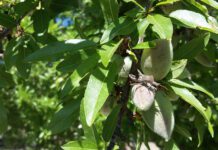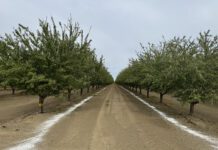As we wind down almond harvest, ramp up pistachios and roll into walnuts and pecans, the fast and furious comes in like a lion and goes out like a lamb. Although it’ll be a slower pace for a while, you’re not done yet. I’m always harping on postharvest plans and making sure they are in place before it’s too late. I’ve used the analogy in the past of the triathlete. After a long race, like our trees just went through, they never just go home, take a shower and go to bed. They eat. They must replenish their carbohydrate storage in the muscles for recovery and repair. Our trees act in much the same way. After producing all those delicious nuts we love to eat, we must feed our trees to prepare for winter, repair the harvest damage and store some food. We need them to do it again next year, and do it well, again and again.
Many of my clients used to think of postharvest as something that happens when we amend our soil in November and December. This is not the same as feeding our trees after harvest. IMMEDIATELY! Many of my clients now feed almonds after the Nonpareils are picked up, even before the pollinators are shaken. At the very least, I beg them to get something on when the last nut leaves the rows. There is typically a major root flush happening when trees are preparing to recover. Pistachios can be done between the first and second shakes. That’s the time to give them a good drink of balanced postharvest nutrition. You want to utilize every bit of growing season we have left. The better those trees recover and store, the better equipped they are to maximize bloom in spring.
Hit ‘Em with Everything
Hit them with a solid shot of nitrogen and calcium for building those fine root hairs. Then follow that up with plant-ready phosphorus, potassium and whatever micros you were short of in your last tissue test. A quart or two of magnesium never hurts during postharvest as chlorophyll is critical to producing carbohydrates for winter storage. Remember, Mg is the central element of chlorophyll. If you ended up short on boron (less than 200 ppm in your tissues), add some now. If you have sodium issues, I recommend a boric acid solution instead of the salt option. Zinc and manganese are important for new growth and seed health. And nuts are the trees seeds. Keep these levels up during postharvest recovery. If it’s been a while since you applied it, or you’ve never applied or tested for it, add a pint of cobalt and molybdenum. Molybdenum is very synergistic with N utilization and great for soil health. Co is the key element in vitamin B, which has been used as a plant food nutrient for decades under the label of the vitamin, not the element. Add a pint per acre.
Logistically, this may seem tough to do with those nutrients that don’t play well together. However, consider shorter sets more often for recovery. You can run several 12-hour sets, separated by a few days and keep adding those different forms of nutrition. None of it has to be applied all in one shot. And if those leaves are still covered in dust from harvest, consider a foliar spray. You can add those micros while cleaning the leaves off at the same time, further enhancing your photosynthesis. This will also allow you to run some calcium downstairs while you spray orthophosphorus upstairs. This enables you to get two nutrients that can’t be mixed in decent concentrations together into a tree at almost the same time.
If you have followed the guidelines of whichever favorite professor you agree with and saved the recommended 25% N amount for postharvest applications, add that in three sets instead of one. Give the trees a better chance to absorb it all. And start early. We lose so much efficacy the longer we wait to apply our postharvest nutrients. As we get closer to leaf abscission, nutrients stop getting assimilated onto the fruit wood and back down into the trunk and roots. We can get a better nutrient load dispersal the earlier we start.
Take advantage of that and accumulate higher concentrations throughout the trees. Many of those nutrients should be closer to the blooms when all hell breaks loose next spring.
I know I harp on this every fall in hopes that many will take it to heart. Nitrogen and phosphorus start high in the spring, and they need a healthy mix of nutrients to carry out all the enzymatic reactions necessary for growth and bloom. Postharvest is way more critical than we previously thought to start those trees out right after winter. Missing this critical step in the health of an orchard can be detrimental. Being late can hurt almost as much. Be diligent, plan now and get it going. Even a small, early shot of a balanced NPK with some micros will help much more than doing nothing. The earlier you start, the better chance you have of assimilation. Waiting too long or just thinking the soil amendment apps will suffice is probably leaving higher yields out in the cold.
















